|
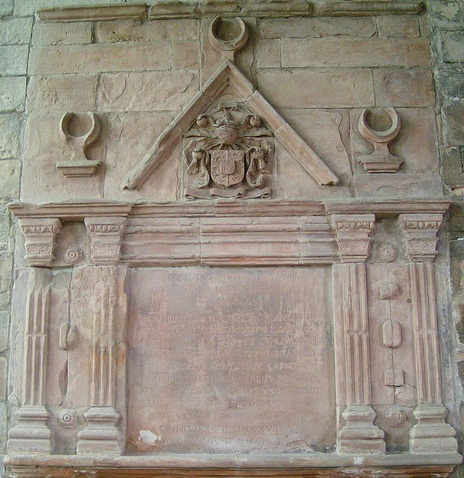 The function of the Coat of Arms is to
identify the person who is the head of a given family. They are used
in many ways in connection with the administration
and government of the estate, for instance on
documents, coins, in churches and on family buildings. To most people
they are familiar appearing on various
products and goods. The Seton Coat of Arms, of
Scotland and the United Kingdom, have evolved over many
centuries
and reflect the history of the family, and of the
country. The function of the Coat of Arms is to
identify the person who is the head of a given family. They are used
in many ways in connection with the administration
and government of the estate, for instance on
documents, coins, in churches and on family buildings. To most people
they are familiar appearing on various
products and goods. The Seton Coat of Arms, of
Scotland and the United Kingdom, have evolved over many
centuries
and reflect the history of the family, and of the
country.
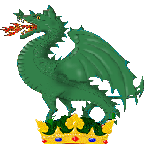 On a ducal coronet, a Wyvern, Vert, wings elevated and sprouting fire,
proper. On a ducal coronet, a Wyvern, Vert, wings elevated and sprouting fire,
proper.
Originally the Seton Crest was an Antelope
Head, as illustrated on the right.
This emblem came with Seier and Walter de Lens
and is still carried by Walter's descent, the Fleming family of Scotland.
The
Wyvern Crest, on the left, came into the Seton family upon their inheritance of the de Quincy
estate. In the 12th century, through the marriage of Walter de Seton (also
called Dougall, from the corrupted french, 'du gaul') and the heiress, Janet de Quincy. After this time the
Seton family assumed the de Quincy crest of the Wyvern.
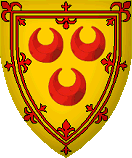 In the
root of the design, the shield shows
the emblems of royal association, and of the
Flemish descent: the three crescents signify
descent from the second son of the Flemish House
of Boulogne, and they are surrounded by the double tressure
signifying descent from the Scottish Royal
Family, and bearing
the motto
Hazard Yet Forward,
'that no matter what difficulty or peril, we will
continue or progress on', which symbolizes
the family's creed and devotion to the Royal
cause. As an ancient family, they were
members of the order of
knighthood from the earliest times and the symbols
and motto's were of great importance in
identifying family members in battle. The
double tressure was given by King Robert I, the
Bruce, in 1301 upon the marriage of Sir
Christopher Seton III with his sister, Lady
Christian Bruce, and which marriage made their
son, Sir Alexander Seton, a lineal heir to the
Scottish Crown. In the
root of the design, the shield shows
the emblems of royal association, and of the
Flemish descent: the three crescents signify
descent from the second son of the Flemish House
of Boulogne, and they are surrounded by the double tressure
signifying descent from the Scottish Royal
Family, and bearing
the motto
Hazard Yet Forward,
'that no matter what difficulty or peril, we will
continue or progress on', which symbolizes
the family's creed and devotion to the Royal
cause. As an ancient family, they were
members of the order of
knighthood from the earliest times and the symbols
and motto's were of great importance in
identifying family members in battle. The
double tressure was given by King Robert I, the
Bruce, in 1301 upon the marriage of Sir
Christopher Seton III with his sister, Lady
Christian Bruce, and which marriage made their
son, Sir Alexander Seton, a lineal heir to the
Scottish Crown.
The English branches of the Seton family
maintained arms that while maintaining the
tinctures, reflected different loyalties and
thus no longer bore the three crescents.
Arms borne by Jan de Seton of the family's
estates in Yorkshire, for example, were: Or, a
saltire gules and on a chief gules three garbs,
Or.
In the arms of the head of the family
stemming from the 7th Lord Seton's time and his
descent, the Earl's of Winton, the shield is supported by
two mertrix's rampant, or Scottish wildcats, which
represent the lesser status in the Royal lineage: the Scottish
sovereign's symbols being the Lion Rampant.
Later, below the shield appeared the motto of the
Head of the Family, Invia Virtute Via Nulla ('No
road to virtue is too great'). The plant badge of the
family -
Yew - which tree signifies:
death and eternal life thereafter.
The quartering of
the Seton Arms originate from the union of the
various families with the House. The
earliest quartering would be:
- Seton and Gordon,
which were brought about by the marriage with the
heiress of Gordon and which brought the Lordship
of Gordon and the later Earldom of Huntly to the House;
- Seton and Meldrum, which were brought about
by
the marriage of the second son of the 1st Lord Gordon and
the heiress of Meldrum and established the Seton's
of Meldrum;
- Seton and Hay, which
were brought about by the marriage of the second
son of the 1st Earl of Huntly with an early Hay
family heiress and established the Seton's of
Touch and Tullibody;
- Later, the Head of the House of
Seton's Arms were quartered with the Arms of the
Earldom of Buchan when George, 3rd Lord Seton
married the heiress of John Stewart, Earl of
Buchan, grandson of the King.
Robert, 8th Lord Seton, on being created Earl
of Winton, was allowed the additional coat of
augmentation, viz., Azure, a star of twelve
points Argent, within a double tressure flowered
and counter- flowered. Or.
The motto 'Intaminatis Fulget
Honoribus' was added by the Earls of Winton upon
ascension to that station in the peerage.
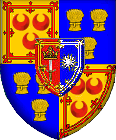 The special escutcheon, (or small coat of arms)
in the center of the Seton Arms: Gules, a sword
proper, pomelled and hilted supporting and antique
crown within a double tressure flory counter-flory,
Or;
was awarded by King Robert I, in recognition for the family's
endurance during the wars for Scottish independence,
and for adherence to the Royal Crown, and in
particular for Sir Christopher Seton, his famed
adherent, who was captured and executed by the
English during the wars. The special escutcheon, (or small coat of arms)
in the center of the Seton Arms: Gules, a sword
proper, pomelled and hilted supporting and antique
crown within a double tressure flory counter-flory,
Or;
was awarded by King Robert I, in recognition for the family's
endurance during the wars for Scottish independence,
and for adherence to the Royal Crown, and in
particular for Sir Christopher Seton, his famed
adherent, who was captured and executed by the
English during the wars.
Later,
upon the ascension to the Earldom of Winton, a
further augmentation was added: that of the
escutcheon with the white
blazing sun which signified the rise of the family
and the light on the path to virtue. Both of
these additions were incorporated into one escutcheon, with the old on the dexter and the
new on the sinister.
The dignity of Earl of Winton had been
conferred upon Robert, eighth Lord Seton, the
eldest brother of the President, on account of
his faithful services, and those of his
ancestors, to the House of Stuart. This was the
first Scottish patent of Peerage, and the only
one granted by the King before his accession to
the English throne, its phraseology being
borrowed from the south side of the Tweed.
It refers to the symbolical
act of investiture called Belting, or cinctura
glaxii which, contrary to the ordinary practice,
had preceded the issue of the patent, the
ceremony having been performed with great
solemnity at Holyrood, accompanied by the usual
creation of knights. Nisbet alludes to the
" coat of augmentation" granted on the same
occasion, as the earliest example of that
heraldic honour — viz., azure, a blazing star of
ten points, within a double tressure, flowered
and counter-flowered or, with the motto
Intaminatis fulget honoribus, "to show the
constant loyalty and heroic virtue of the
family".
On a large detached stone in Seton Church,
believed to have formerly surmounted the
principal doorway of Seton Palace, the full
Winton arms are sculptured in high relief, the
only charges in the inescutcheon being the star
and Royal tressure, as on the seal of George,
third Earl, in 1608.
The Winton inescutcheon also appears on a
damask napkin in the possession of the writer,
bearing the name of the maker — " John Ochiltrie,
weaver in Edinburgh," and exhibiting the
armorial ensigns of George, fifth Earl of
Winton, under the following legend : — Insignia
George IX. de Seton, Comitis de Winton, Domini
de Seton. Over the shield is an Earl's
coronet surmounted by helmet, crest, and motto ;
and behind, two batons in saltire, in allusion
to the office of Master of the Royal Household
formerly held by the family. The
supporters hold banners, of which the dexter is
charged with the arms of Seton, and the sinister
with a circle and triangle interlaced,
surrounded by the word Indissoluble, the device
adopted by George, fourth Lord Seton, on the
ensign of the ship "Eagle," which he equipped to
avenge himself against an attack by the
Dunkirkers. In the four corners are
interlaced crescents and other devices, with
legends, the whole being within a bordure
charged with crescents and fleurs-de-lis.
The seal of Robert, Lord Seton, in 1600,
presents a variation of marshalling ; the
crescents of Seton being there quartered with
the garbs of Buchan, and the whole surrounded by
the Royal tressure.
|
 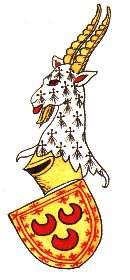
Arms
of Sir William Seton, 1st Lord Seton
|
